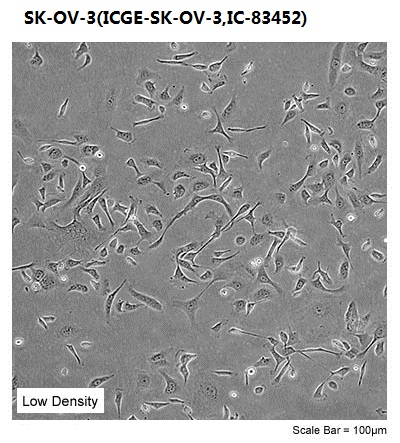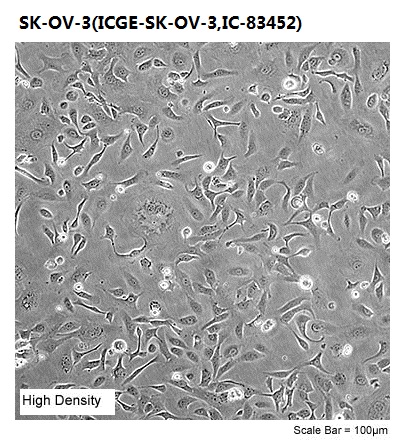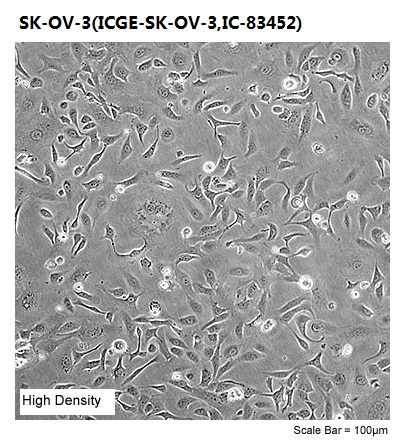


Overview
| Permits and Restrictions | |
|---|---|
| Organism | Homo sapiens, human |
| Tissue | ovary: ascites |
| Product Format | frozen |
| Morphology | epithelial |
| Culture Properties | adherent |
| Biosafety Level |
1
Biosafety classification is based on U.S. Public Health Service Guidelines, it is the responsibility of the customer to ensure that their facilities comply with biosafety regulations for their own country. |
| Disease | adenocarcinoma |
| Age | 64 years |
| Gender | female |
| Ethnicity | Caucasian |
| Applications |
This cell line is a suitable transfection host.
|
| Storage Conditions | liquid nitrogen vapor phase |
Properties
| Karyotype | This is a hypodiploid human cell line. The modal chromosome number was 43, occurring in 63.3% of cells. The range was 42 to 45. The rate of higher ploidies was 32%. The del(1)(q21), der(13)t(1;?;13) (q11;?;q34), der(11)t(11;?) (q12), del(10)(q22) and 3 other marker chromosomes were common to most cells, and 3 others were found only in some cells. One N11 had the HSR segment from p11 to the distal end. The normal N10, N12, N15, N17 and N19 were absent. Others were either single or paired. There were from 1 to 6 rearranged and unassignable chromosomes. The X chromosome was either single or paired. |
|---|---|
|
|
|
| Clinical Data |
64 years
Caucasian
female
|
| Antigen Expression |
Blood Type B; Rh+
|
| Genes Expressed |
Blood Type B; Rh+
|
| Tumorigenic | Yes |
| Effects |
Yes, in nude mice; forms moderately well differentiated adenocarcinoma consistent with ovarian primary
|
| Comments |
SK-OV-3 cells are resistant to tumor necrosis factor and to several cytotoxic drugs including diphtheria toxin, cis-platinum and adriamycin.
|
Background
| Complete Growth Medium |
The base medium for this cell line is ATCC-formulated McCoy''''''''s 5a Medium Modified, Catalog No. 30-2007. To make the complete growth medium, add the following components to the base medium: fetal bovine serum to a final concentration of 10%. |
|---|---|
| Subculturing |
Protocol:
Subcultivation Ratio: A subcultivation ratio of 1:2 to 1:6 is recommended
Medium Renewal: 2 to 3 times per week
|
| Cryopreservation |
Freeze medium: Complete growth medium supplemented with 5% (v/v) DMSO
Storage temperature: liquid nitrogen vapor phase
|
| Culture Conditions |
Atmosphere: air, 95%; carbon dioxide (CO2), 5%
Temperature: 37.0��C
|


